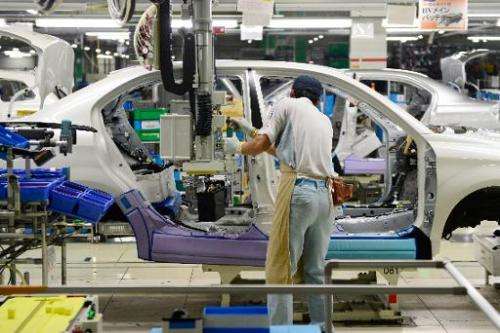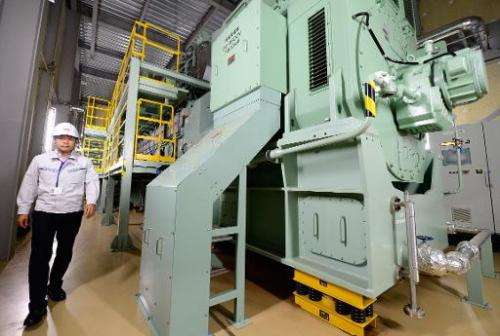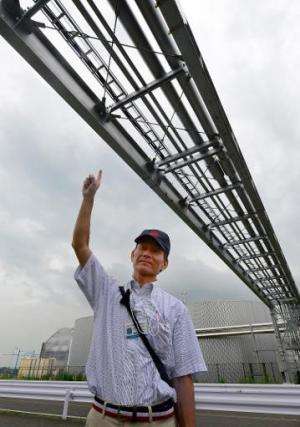Producing your own power in post-Fukushima Japan

A remote Toyota plant in northeastern Japan bears few scars from the devastating quake-tsunami more than two years ago that completely shut it down.
Employees roll out more than 100,000 Corolla and Yaris sedans a year and the factory looks like most operated by the world's biggest automaker.
But the plant is unusual for something that cannot easily be seen: it produces its own power.
A gas-fired power system supplies 7,800 kilowatts of energy—about 70 percent of present needs—to help keep production moving, and virtually nothing is lost.
The factory recycles heat from the burning of gas and uses it to dry the paint on finished vehicles. Hot water from the gas turbine runs through pipes into a nearby greenhouse that grows green peppers, which will later be sold. Solar panels also supply some power to the plant.
The factory is tapped into the local energy grid and could supply the nearby village of Ohira in case of another disaster.
"We produce electricity for us, but also emergency power for local businesses and the town," said Toyota official Makoto Sogo, raising his voice above a deafening turbine.
That is a crucial change for the 5,600 residents of Ohira, in Miyagi prefecture, whose coastline was flattened by the monster waves that crashed ashore after a 9.0 magnitude earthquake in March 2011.
The twin disasters caused widespread power outages in communities such as Ohira and were quickly followed by the crisis at the Fukushima nuclear power plant, the worst atomic accident in a generation.
"Life just stopped after 2011," said Ohira mayor Masahiro Atobe.
"So we wanted to avoid a repeat of this situation at all costs and make sure it never happens again."

The changes at the Toyota plant earlier this year are one part of a post-disaster energy revolution in Japan.
With anti-nuclear sentiment running high and safety in question, Tokyo temporarily switched off the nation's 50 reactors, which had once supplied about one-third of Japan's power.
They remain offline but the ruling Liberal Democratic Party is pushing for restarts as Japan's energy import bills soar.
The shutdown forced a countrywide rethink on energy use—and supply.
The Japanese government has stepped into the green power market to set minimum prices in a bid to encourage the sector.
Last year, Tokyo introduced a scheme that guaranteed generating companies a premium for the electricity produced from renewable sources and forced the country's huge power monopolies to buy however much electricity was produced by green-energy plants over the next 20 years.
The move was part of a plan to dramatically increase the amount of electricity from renewables—currently it is less than two percent—and reduce resource-poor Japan's reliance on expensive imported fossil fuels.
The country is now on track to lead the solar energy market this year, some analysts say, while the world's largest offshore wind farm is being built off the battered northeast coast.
In Miyagi, the self-sufficiency at Toyota's plant means it could keep operating even in the event of another huge natural disaster, instead of grinding to a halt like it did in March 2011.

That was a fate suffered by many industrial plants across the country as local power utilities were pushed beyond their limits.
Smaller producers are now cropping up with the government's feed-in tariff for green energy suppliers helping to diversify power sources.
"After 2011 everyone started to realise that it was necessary to be dependent on oneself to a certain extent since the country has previously depended on big utilities," said Takanobu Aikawa, an energy researcher at Mitsubishi UFJ Research and Consulting.
Toyota is not alone, with rival automakers also jumping into the power-producing field.
Honda's plant in Yorii, northeast of Tokyo, is covered with solar panels and also has an on-site gas plant with a 2,600 kilowatt capacity.

Mitsubishi installed a mini gas plant at a Kyoto facility—following a request from the local power company.
A loosening of rules on purchasing electricity, which started in the late nineties, has paved the way for Nissan to flexibly buy power for four sites—including its Tokyo-area headquarters—from new producers as well as the long-standing utilities.
"The changes that have started will not stop so I expect the energy situation in Japan to change dramatically over the next 10 years," said Mitsubishi's Aikawa.
© 2013 AFP





















